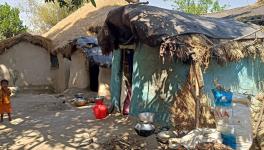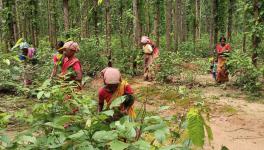Bengal: Who’s Responsible For Raging Forest Fires in Bankura?

Burning Susunia Hill Bankura
The fire was raging in the forest of Bankura in Jangal Mahal, with the flames spreading rapidly due to wind pressure. The eerie silence of the forest was often broken by the melodious yet pitiful sounds of various bird species, desperately trying to survive. Amidst the heat of the fire and coils of smoke, animals, such as hares, deer, porcupines, wild boars, and various species of snakes, could be seen fleeing. But, where would they find shelter?
After a long wait, the fire brigade’s alarm was finally heard. It took 10-15 hours for them to extinguish the fire. In the aftermath, amid the thick smoke, the scorched ground was littered with dead porcupines, birds, snakes, rabbits, wild boars, and foxes. The insects had turned into ashes.
This terrible scene of forest fires has spread across the Jangal Mahal area of Bankura district. The frequency of these fires is increasing every year, says locals. But, why is this so? The answer lies in the sequence of events in Jangal Mahal after the fire was extinguished. The administration, forest department, local panchayat, and elected representatives at the Assembly and Parliament levels, all aware of the situation, remained silent observers.
Forest Area of Bankura and its Greening History
The current forest area of Bankura and how the once-destroyed forest became greener have been in the news. It is well-documented that until the late 1970s, Bankura district was one of the most economically backward districts in West Bengal. Thousands of hectares of land lay uncultivated; there were no irrigation facilities. Agricultural production, including rice and potatoes, had reached its lowest point, and for a long time.
Bankura district had no industry. Due to this dire economic structure, the poor and marginalised people had no work and were unable to buy rice at high prices from the black market. JyansankarMitra, a senior citizen and former sabhadhipati (head) of Bankura Zilla Parishad, told this writer that approximately 70% of the population in the district faced food shortages. Poor and jobless people from villages and towns used to often stage protests at Block Development Offices, demanding a meagre 2 kilograms of wheat or rice. People were suffering from extreme malnutrition. Several residents who witnessed that period recalled a saying, "Kangali Bhojon" (poor person's lunch), indicating that during festivals at wealthy families' homes, poor people would rush to get a full meal.
With no alternative sources of income, these poor villagers became dependent on the forest. They collected forest resources and sold them, and even cut down tree branches and trees. Unscrupulous wood traders took advantage of their poverty, paying them small wages for this work. The Forest Department was unable to stop this, and the government paid no attention. As a result, the forests of Bankura were rapidly destroyed. By the end of 1977, the forest area of the district had shrunk to only 12%.
Women are collecting leaves from Onda forest
After the Left Front government came to power in Bengal in 1977, the Land Reform Act was implemented. As per the Act, land exceeding the ceiling was transferred to the state government's land department. Much of this land had been held by landlords under the names of family members and others, without being cultivated.
After legally reclaiming these lands, the Left Front government distributed them among the poor landless people as patta (permanent settlement of land). A three-tier panchayat system was created. The panchayat and various government departments introduced several schemes to help the poor landholders. Agricultural production increased within three years, and the poverty levels began to decrease.
Along with land reform, an initiative to rebuild the forest of the district was undertaken in the name of ‘social forestry’. Various species of trees, including teak, Akashmoni, eucalyptus, sandalwood, and banyan, were planted across Bankura's forest area. Seed nurseries were established in several places within the district. The panchayat, Forest Department, and Horticulture Department jointly carried out this work.
"At that time, it was a great challenge for us, but we were committed to rebuilding the greenery," said Subrata Goswami, a retired ranger of the Bankura Panchet Forest Division.
Recalling that period, Nayan Hansda, a 75-year-old resident of Sutan village in Ranibandh, recalls that the destroyed forest turned green within four to five years. The greenery spread in areas including Joypur, Patrasayer, Sonamukhi, Barjora, Taldangra, Bishnupur, and Sarenga. He said Forest Protection Committees (FPC) were created with approval from the Forest Department. Women and men from forest-adjacent areas were made members of these committees. The forest staff, including bit and range officers, held monthly meetings with them. The panchayat also maintained contact. Villagers could collect forest fruits, flowers, leaves, and fallen branches. Additionally, the committee members received 25% of the selling price after cutting mature trees to protect the forest.

"The Forest Department built community centres, wells, playgrounds and school buildings for the villages. Members were given umbrellas and winter clothes," Sunil Basuli, a retired range officer of Barjora Range told this writer.
"A family relationship developed between forest staff and FPC members. As a result of their 24-hour vigilance, there was no damage to the forest. It grew rapidly and turned dense. Peacocks, deer, rabbits, and various snake species could be seen. Herds of elephants from Dalma started coming to Bankura forest in 1984," he recalled.
According to satellite observation, the total forest area of Bankura district, comprising three divisions—Bankura (North), Bankura (South), and Panchet Division—is about 1,463.56 km², covering 21.27% of the total land area of the district, compared with Bengal's overall forest coverage of 18.96%.
Is Forest Greenery Gradually Decreasing?
Over the past five years, from mid-February to the end of May, miscreants have been setting fire in various parts of Bankura forest. The pattern of these fires suggests a deliberate and coordinated effort, as the fires are set in areas densely populated with valuable trees like Sal, teak, and Akashmoni. After the fires are extinguished, the burned trees mysteriously disappear within a week. Where are these valuable trees going? Despite knowing about these fires, the concerned range offices are not filing First Information Reports (FIRs) with any police station. Why?
A few days ago, the Baromile Jungle of Ranibandh forest, which covers the largest forest area in Bankura district, was burning. This area, located on the way from Ranibandh to Jhilimili, has experienced similar fires at the same time for the past five years. The flames spread from the roadside deep into the Baromile forest. Despite the fire brigade's efforts, the fire continued for 24 hours.
Fifteen days ago, a similar fire occurred in Barjora forest, where four fire brigade engines from Bankura and Durgapur tried to douse the flames. The trees in the forest were left standing, blackened and scorched. Similar incidents have been reported in Joypur, Patrasayer, Bishnupur, Basudebpur, Kanchanpur, Sonamukhi, Beliatore, Gangajalghati, Mankanali, Taldangra, and Sarenga forests—major forest areas in the district.
Additionally, many small and medium-sized natural and planted forests have been set on fire. Not a single forest area has been free of such fires. Even Susunia Hill, a prominent mountain climbing centre in Bengal, and the ancient Bamnisini hills of Ranibandh have not been spared. These hills, which are 400 meters in height, have seen fires continuously for years due to their valuable trees. Locals allege that most of the trees were burned and looted.

Burning Susunia Hill Bankura
“For five months, several forests have been on fire almost every day. There are only six fire stations in Bankura district, with a limited number of workers and no new recruitments. Sometimes, we are late in reaching the locations,” Khalid Ansary, an officer at the Bankura fire station, told this writer He added that if news of fires comes from 10 places simultaneously, it is impossible to reach all of them.
When asked why the forest was constantly seeing fire during these four months, Divisional Forest Officers (DFO) Umar Imam of Bankura North and Pradip Bauri of Bankura South said the exact reasons were unclear. However, many unknown travellers or locals smoke in the forest and carelessly discard burning cigarettes and bidis, igniting the dry forest. They also mentioned that some people start fires for amusement. The forest department is promoting awareness to prevent such actions and is keeping a vigil on this matter.
Former Range Officer Sunil Basuli said, “During the Left Front period, even a small fire in the forest would result in an FIR being filed with the local police station by the concerned bit or range office, and a copy of the FIR would be sent to the forest department headquarters. I do not know if this happens now.”
He said earlier, FPC members used to protect the forest. They held annual general meetings to elect office bearers, but such meetings have not occurred for several years. FPC members have lost contact with the forest department.
Jadunath Saren, an FPC member of Dalangora under Taldangra block, said that while the committee was officially active, it was practically non-existent. Several FPC members across the district allege that ruling Trinamool Congress activists have taken over, leading to local disappointment and reluctance to risk their lives to save the forest.
“There have been no new appointments for 12 years. How can two forest staff monitor such a vast area?” said a forest staff member from Ranibandh who wished to remain anonymous. As a result, trees are being looted indiscriminately after fires and in normal conditions. Many medicinal plants are dying due to deforestation, and numerous porcupines have perished on Susunia Hill. Many animals, including deer, snakes, wild boars, and rabbits, are dying. A few days ago, three deer died in the Baromile forest fire in Ranibandh, he said.
Residents of Ranibandh Baromile jangle area.
Towards the end of the monsoon, the forest produces several species of mushrooms around the bases of trees, which are in high demand due to their taste and market value. Local women collect these mushrooms to sell in the market. Many women from forested areas of the district have reported that mushroom production is decreasing due to the burning soil, negatively impacting their livelihoods.
Professor Asis Bhattacharya, former Head of the Department of Zoology at Bankura Sammilani College, told this writer that forest fires harm biodiversity and the ecological system. Many birds that eat the fruits of medicinal plants help those plants regenerate by spreading their seeds through defecation. These birds are dying in the fires, preventing the growth of new plants. Furthermore, increased carbon in the air from the fires can cause respiratory and skin diseases among local residents.
The deep forest created by the people of Bankura has made the district known as ‘Jangal Mahal’ (Forest Palace) in Bengal. However, if the forests continue to be destroyed at this rate, will Bankura still be known as Jangal Mahal?
The writer covers the Jangal Mahal region for Bengali daily ‘Ganashakti’ in West Bengal.
Image credit: Madhu Sudan Chatterjee
Get the latest reports & analysis with people's perspective on Protests, movements & deep analytical videos, discussions of the current affairs in your Telegram app. Subscribe to NewsClick's Telegram channel & get Real-Time updates on stories, as they get published on our website.
























